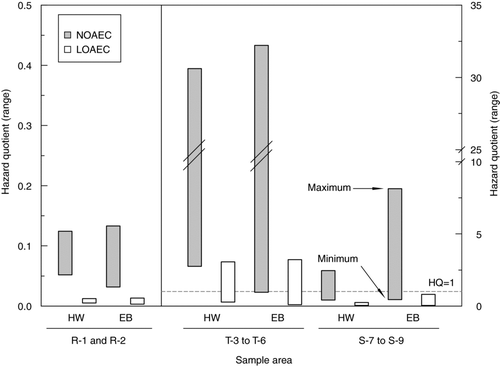Figures & data
Figure 1 Study site locations within the Chippewa, Tittabawassee, and Saginaw river floodplains, Michigan, USA. Reference Areas (R-1 to R-2), Tittabawassee River Study Areas (T-3 to T-6), and Saginaw River Study Areas (S-7 to to S-9) were monitored from 2004–2007. Direction of river flow is designated by arrows; suspected source of contamination is enclosed by the dashed oval.
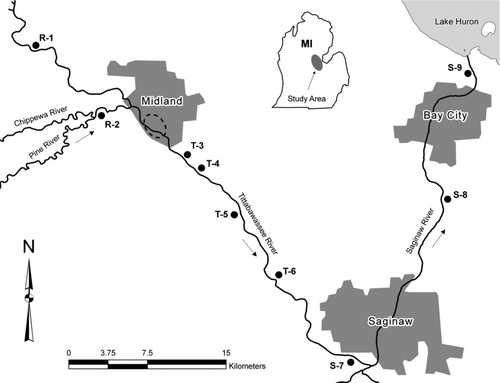
Table 1 Toxicity reference values (TRVs) for total TEQsWHO-Avian Footnote a concentrations selected for comparison to terrestrial passerines exposed to PCDD/DFs in the river systems downstream of Midland, Michigan, during 2005–2007.
Figure 2 Geometric mean concentrations of ΣPCDD/DF TEQsWHO-Avian in house wren eggs collected during 2005–2007 from the river floodplains near Midland, Michigan. Error bars show the 95% upper confidence level (UCL); Reference areas (R-1 and R-2); Tittabawassee River study areas (T-3 to T-6); and Saginaw River study areas (S-7 and S-9); sample size is indicated in parentheses under the sample site.
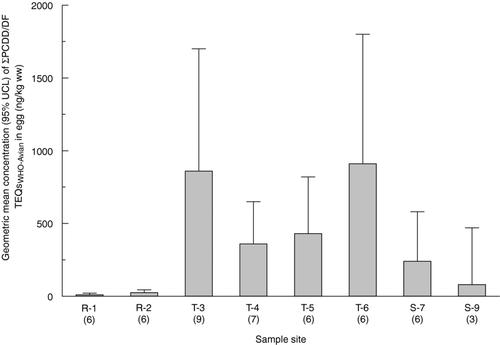
Figure 3 Geometric mean concentrations of ΣPCDD/DF TEQsWHO-Avian in eastern bluebird eggs collected during 2005–2007 from the river floodplains near Midland, Michigan. Error bars show the 95% upper confidence level (UCL); Reference areas (R-1 and R-2); Tittabawassee River study areas (T-3 to T-6); and Saginaw River study areas (S-7 and S-9); sample size is indicated in parentheses under the sample site; range presented for S-7 where n = 2.

Table 2 Potential average (range) TEQWHO-Avian Footnote a daily dose (ADDpot; ng/kg body weight/d) calculated from site-specific bolus-based and food web–based dietary exposure for adult house wrens and eastern bluebirds breeding during 2004–2006 within the river floodplains near Midland, Michigan.
Figure 4 Correlation plot of percent hatching success and ΣPCDD/DF TEQsWHO-Avian in house wren eggs for nesting attempts with data collected for both variables from the river floodplains near Midland, Michigan during 2005–2007. R- and p-values and sample size indicated; 1 = R-1; 2 = R-2; 3 = T-3; 4 = T-4; 5 = T-5; 6 = T-6; 7 = S-7; 9 = S-9.
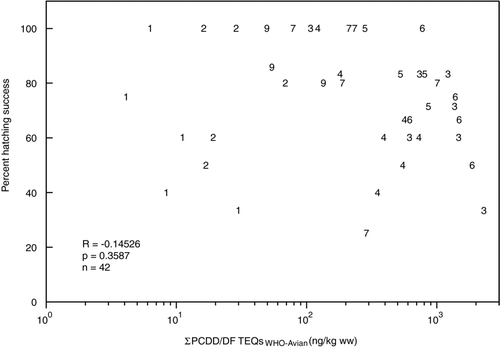
Figure 5 Correlation plot of percent hatching success and ΣPCDD/DF TEQsWHO-Avian in eastern bluebird eggs for nesting attempts with data collected for both variables from the river floodplains near Midland, Michigan during 2005–2007. R- and p-values and sample size indicated; 1 = R-1; 2 = R-2; 3 = T-3; 4 = T-4; 5 = T-5; 6 = T-6; 7 = S-7.
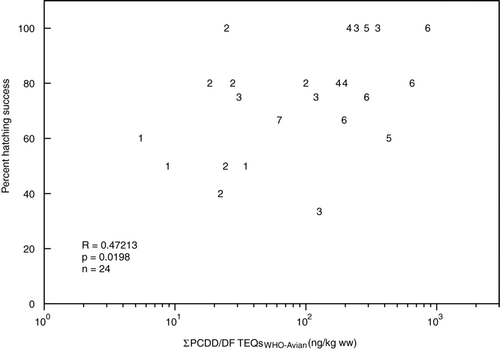
Figure 6 Modeled probabilistic distribution of expected cumulative percent frequencies for house wren egg TEQWHO-Avian concentrations ng/kg ww in site-specific eggs collected from the river floodplains near Midland, Michigan in 2005–2007. 10,000 simulations per site; R-1 and R-2 indicated by solid lines; T-3 to T-6 indicated by dash-dot-dash lines; S-7 and S-9 indicated by dotted lines; Y-axis offset to show R-1 and R-2; NOAEC and LOAEC indicated by vertical bars.
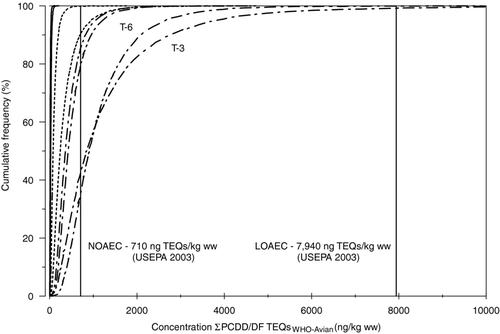
Figure 7 Modeled probabilistic distribution of expected cumulative percent frequencies for eastern bluebird egg TEQWHO-Avian concentrations ng/kg ww in site-specific eggs collected from the river floodplains near Midland, Michigan in 2005–2007. 10,000 simulations per site; R-1 and R-2 indicated by solid lines; T-3 to T-6 indicated by dash-dot-dash lines; S-7 indicated by a dotted line; Y-axis offset to show R-1 and R-2; NOAEC indicated by a vertical bar; LOAEC (not indicated) is 10,000 ng TEQs/kg ww (CitationThiel et al. 1988).

Figure 8 Hazard quotients (HQ) for the effects of ΣPCDD/DF TEQsWHO-Avian for house wren eggs collected in 2005–2007 from the river floodplains near Midland, Michigan, based on the no observable adverse effect concentration (NOAEC) and the lowest observable adverse effect concentration (LOAEC). 95% confidence intervals (LCL/UCL) based on the geometric mean concentrations are presented; Left y-axis for reference areas (R-1 and R-2); Right y-axis for Tittabawassee River study areas (T-3 to T-6) and Saginaw River study areas (S-7 and S-9).
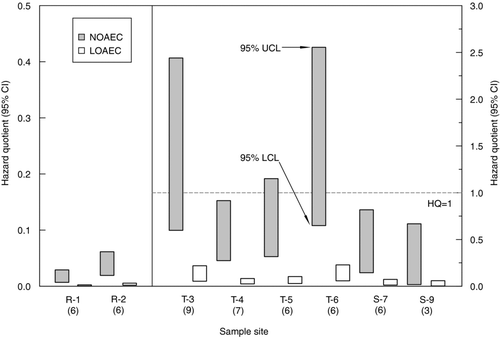
Figure 9 Hazard quotients (HQ) for the effects of ΣPCDD/DF TEQsWHO-Avian for eastern bluebird eggs collected in 2005–2007 from the river floodplains near Midland, Michigan, based on the no observable adverse effect concentration (NOAEC) and the lowest observable adverse effect concentration (LOAEC). 95% confidence intervals (LCL/UCL) based on the geometric mean concentrations are presented; range presented for S-7 where n = 2; Left y-axis for reference areas (R-1 and R-2); Right y-axis for Tittabawassee River study areas (T-3 to T-6) and Saginaw River study areas (S-7 and S-9).

Figure 10 Hazard quotients (HQ) for the effects of potential ΣPCDD/DF TEQsWHO-Avian daily dietary dose calculated from site-specific bolus-based (R1 to T-6) and food web–based (S-7 to S-9) dietary exposure for adult house wren and eastern bluebird collected in 2005–2007 from the river floodplains near Midland, Michigan, based on the no observable adverse effect concentration (NOAEC) and the lowest observable adverse effect concentration (LOAEC). HQs based on measured concentration ranges are presented; Left y-axis for reference areas (R-1 and R-2); Right y-axis for Tittabawassee River study areas (T-3 to T-6) and Saginaw River study areas (S-7 to S-9); food web–based dietary exposure is presented for S-7 to S-9 since no bolus samples were collected from those sites.
